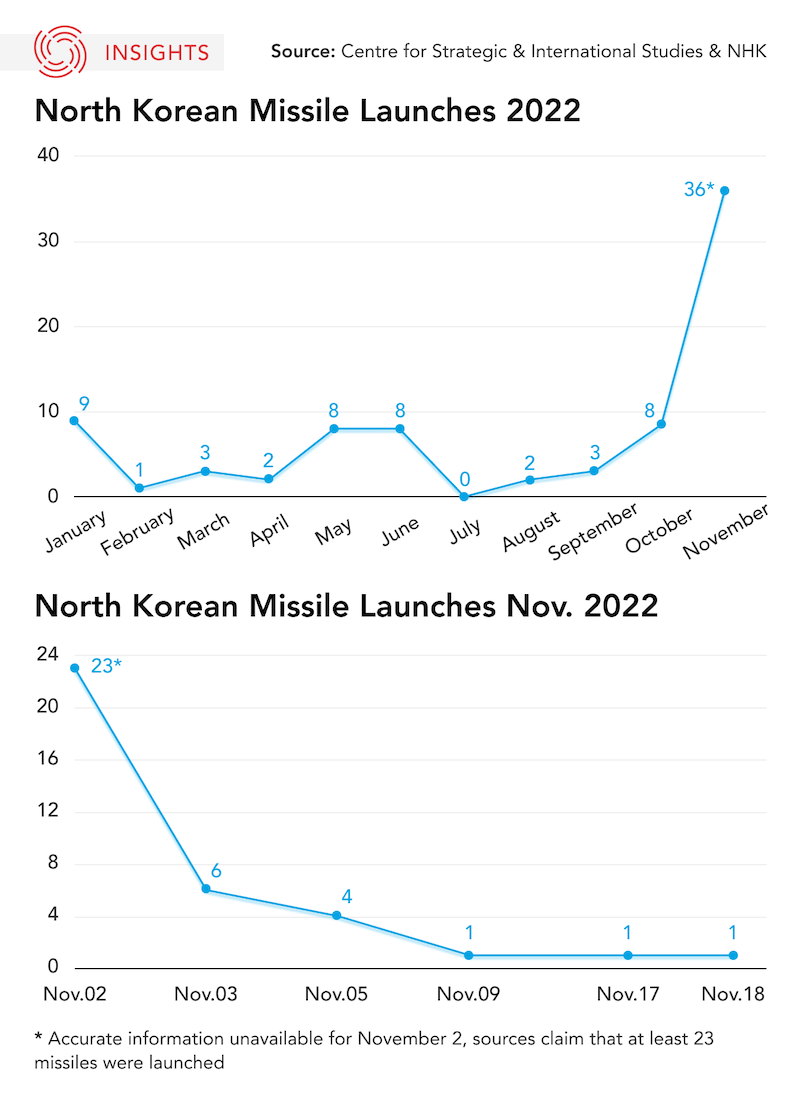The Takeaway
On November 15, amid North Korea’s daily armed protests against security co-operation between South Korea, the U.S., and Japan, the country’s foreign ministry verbally attacked countries, including Canada, that criticized its missile launches, and began firing more missiles on November 17 and 18. Such verbal and military provocations are heightening regional tensions.
In Brief
South Korean President Yoon Suk Yeol, US President Joe Biden, and Japanese Prime Minister Kishida Fumio held a tripartite talk in Phnom Penh, Cambodia, on November 13, and released yet another joint statement declaring strengthened co-operation to deter North Korea’s military threats. On November 16, the UN Third Committee supplemented the three counties’ efforts to rein in North Korea by adopting a resolution condemning North Korean human rights violations for the 18th consecutive year. South Korea participated in the adoption of the UN resolution for the first time in four years.
In response to these international warnings, North Korean Foreign Minister Choe Son-hui condemned the trilateral joint statement and North Korea fired a short-range ballistic missile on November 17. The following day, the country launched an intercontinental ballistic missile that fell in Japan’s exclusive economic zone, west of Hokkaido. In addition, North Korea’s Foreign Ministry and state-backed propaganda media have also lashed out at countries that have supported the three countries’ shared hard-line position towards North Korea.
Implications
North Korea has never been shy in hiding its sharp criticisms of what it calls its ‘main enemy,’ South Korea, the ‘imperialist aggressor,’ the U.S., and the ‘colonial plunderer,’ Japan. However, since June 2021, when North Korean leader Kim Jong Un declared a power-to-power confrontation against South Korea and the U.S., the North has retorted in a more aggressive and offensive tone, while their hostile retaliations have spread further afield.
On November 15, mentioning “the 1812 U.S. invasion of Canada aimed at occupying the whole Canadian territory,” North Korea’s Foreign Ministry anomalously denounced Canada as a “bat-blind U.S. follower” in response to Canada’s official statement on North Korean provocations on November 4. In response, on November 16, Global Affairs Canada announced its decision to maintain its current stance of condemning North Korea’s missile launches. On November 18, during his participation in the Asia-Pacific Economic Cooperation Leaders’ Meeting in Thailand, Prime Minister Justin Trudeau also strongly condemned North Korea’s nuclear and missile projects.

North Korea’s wide-ranging condemnations and verbal attacks ultimately aim to strengthen its regime and internal solidarity. Together with increased missile launches, the biting remarks are also a measure highlighting the ostensible greatness of Kim Jong Un’s regime by demeaning an ‘enemy’ and emphasizing the country’s achievements.
What’s Next
- Australia in East Asia: On November 15, North Korea also condemned Australia, which sent a naval warship to Busan, South Korea, and participated in the joint South Korea-U.S. naval drill. Analysts are focusing on how Australia will respond to North Korea, amid Australia’s move to strengthen military co-operation with South Korea, the U.S., and Japan to support a free and open Indo-Pacific and rules-based order.
- Canada in East Asia: One of Canada’s Halifax-class frigates, HMCS Vancouver, has been in East Asia monitoring the implementation of UN sanctions against North Korea. It remains to be seen how or if Canada’s monitoring efforts will adapt to these latest threats.
- Impending nuclear crisis: While heightening tensions over the Korean Peninsula, North Korea has rapidly created an atmosphere in which it purports to have no choice but to revive its nuclear testing afte a five-year hiatus. The next North Korean nuclear test is believed to be imminent as it has reportedly completed preparations and is looking for the right timing, with tacit understanding from both China and Russia.
• Produced by CAST’s Northeast Asia team: Dr. Scott Harrison (Senior Program Manager); Momo Sakudo (Analyst); and Tae Yeon Eom (Analyst).
